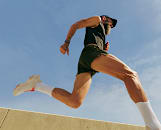
Jordi Salas via Getty Images
Is It Better to Run Longer or Faster? Here's What Experts Say
Both can contribute to your fitness goals—but is there a definitive answer to which is superior?
By Danielle Zickl•
Is It Better to Run Longer or Faster?
Benefits of Running for a Longer Period
Benefits of Running Fast
What Builds More Stamina?
Running Faster vs. Running Longer: What’s Right for You?
How to Combine Speed and Distance Running
There are two main buckets your runs can fall into: fast runs and long runs. You might even have a preference for the types of miles you enjoy logging most. Regardless of which is your ultimate favorite—or if you’re entirely new to the activity—you might be wondering: Is it better to run longer or faster?
Discover more ways to reach your goals with Peloton
Both come with their own distinct perks, but is there a definitive answer to which type of run is superior? We tapped Peloton instructor Mayla Wedekind and physical therapist and run coach Kimberly Melvan, DPT, to get their take.
Is It Better to Run Longer or Faster?
Deciding whether to run longer or faster is entirely dependent on your fitness goals, experience level, and the amount of time you have available, Mayla explains. “If you’re training for endurance, running longer distances at a steady pace is better. If you’re focusing on improving speed, then shorter, faster runs are more effective,” she says.
A balance of both types of runs is ideal for overall cardiovascular fitness, Mayla explains—and Melvan agrees. “The best option is a combination of both throughout the week,” Melvan says. “Even if you’re not worried about improving your pace, speed work is still good for runners to incorporate into their training. The longer runs are the cornerstone of any runner’s training plan—they’re necessary to work on endurance, stamina, and overall running economy.”
Speed training includes sprint intervals, hill sprints, and tempo runs, according to Mayla. These types of runs all come in handy when you’re training for a short-distance race (like a 5K), wanting to improve how efficiently your body transports oxygen to your muscles, or looking to strengthen your fast-twitch muscle fibers.
Distance training involves long, steady-state runs that help build your aerobic capacity, or the maximum amount of oxygen your body can use at one time during intense exercise, according to Mayla.

Peloton App
Access thousands of classes with no equipment needed.
Benefits of Running for a Longer Period
1. It Increases Endurance
There are two types of endurance: cardiovascular (aka aerobic) endurance and muscular endurance. Cardiovascular endurance refers to how efficiently your cardiovascular and respiratory systems are at supplying oxygen to your muscles during sustained periods of exercise, whereas muscular endurance is your muscles’ ability to work over a long period of time without becoming fatigued.
Running for longer stretches increases both types of endurance, Mayla says. Over time, your cardiovascular system becomes more efficient at delivering oxygen to the muscles in need, while your muscles also adapt to produce more energy to support longer workouts.
2. It Builds Mental Toughness
You know the feeling: You’re 12 miles into your 16-mile long run and you want to quit so badly. You’re tired, it’s hot out, and you just want to be at home in a horizontal position on your couch. But you keep going anyway, knowing you need to finish what you started. Indeed, long runs build resilience, Mayla says.
That’s not just the stuff of bragging rights. Mental toughness is a key indicator for successful athletic performance, per a 2017 review in The Open Sports Sciences Journal—and this trait comes with a few other perks as well. For instance, a small 2018 study in the International Journal of Stress Management found a link between mental toughness and lower perceived stress, anxiety, and burnout, as well as fewer depressive symptoms and fewer sleep difficulties.
3. It’s Good for Your Heart
You typically run longer distances at slower paces—if you were to try and sprint all-out for six miles, for instance, you’d burn out almost immediately. And while experienced, faster runners may knock newbies for their reduced speeds, slower paces are actually beneficial to your heart health.
According to a 2014 study in the Journal of the American College of Cardiology that analyzed over 50,000 people, running just five to 10 minutes per day at slow speeds (about six miles per hour, or the equivalent of a 10-minute mile) can reduce your risk of heart disease.
While a 5- or 10-minute run doesn’t qualify as a long run, it does go to show how the slower paces associated with longer runs benefit your heart. Not to mention, actually running for longer durations brings you closer to meeting the recommended amount of cardio activity that the American Heart Association (AHA) recommends to maintain heart health. According to the AHA, you should aim for at least 150 minutes of moderate-intensity exercise per week. If you do a 90-minute long run one Saturday morning, for instance, you’re that much closer to hitting that 150-minute goal—you’d just need 60 more minutes of physical activity that week.
4. It Boosts Your Running Economy
Running for longer periods of time improves your running economy—how fast you can run using a given amount of oxygen at a certain pace—according to Melvan. Think of it this way: You’re looking at two cars to potentially buy. The one that can go farther on a gallon of gas has better fuel economy. The same can be said for runners; if you use less oxygen than your friend while running at the same pace, then you have a better running economy than they do.
Distance running helps with running economy by primarily using slow-twitch muscle fibers, Melvan explains. Slow-twitch muscle fibers are the muscle cells responsible for endurance movements. They use up their energy at a slower pace than fast-twitch muscle fibers (more on those soon), so they’re able to keep you going for longer periods of time.
Research suggests that a greater distribution of slow-twitch muscle fibers is associated with a better running economy. And the more long runs you do, the greater your chance is of changing your body’s distribution to favor this type of muscle fiber (as opposed to fast-twitch), according to a 2021 research paper in Sports (Basel).
Benefits of Running Fast
1. It Boosts Your VO2 Max
Running at faster speeds, like sprinting, improves your VO2 max—the maximum amount of oxygen your body can use during exercise—according to Melvan. This measurement is often referred to as the gold standard for aerobic fitness. The higher your VO2 max, the more cardiovascularly fit you are.
In fact, research has shown that sprint interval training can significantly enhance VO2max in athletes. This is especially true when sprint workouts are done at your max aerobic capacity (90 percent or more of your max heart rate), per a 2022 review in the Scandinavian Journal of Medicine and Sports Science. The reason is quite simple: When you spend time training at your VO2 max, the workouts eventually become easier and you’re able to push harder, thus increasing the number.
2. It Builds Muscle to Enhance Athletic Power and Overall Performance
Speedy running increases both your power and performance, according to both Melvan and Mayla. Sprinting boosts the proportion of fast-twitch muscle fibers—the muscle cells responsible for quick, powerful bursts of movement. The more you sprint, the bigger these muscle fibers will grow, thus the bigger (and stronger) your muscles will get.
The stronger your muscles are, the more power and speed you’ll have. For instance, a small 2017 study in the Journal of Strength and Conditioning Research found that when runners incorporated sprint interval training into their routines, their 3-kilometer (1.8-mile) run time was faster and their power output increased.
Additionally, a 2022 review in Motor Control found that people saw improvements in their vertical jump height after regular sprint training. This can come in handy if you participate in sports other than running, like basketball or volleyball.
4. It Reduces Injuries
While it may seem counterintuitive, there may be a connection between sprinting and lower injury risk. For instance, a small 2017 study in the Journal of Science and Medicine in Sport observed that soccer players who reached nearly 100 percent of their peak velocity in at least one sprint session per week were less likely to have muscle injuries than those who reached around 85 percent of their peak velocity.
“Incorporating sprint work into your training plan can definitely help prevent injuries,” Melvan says. “Sprinting helps build muscle by working on the fast-twitch fibers, but the main goal is to train your muscles to adapt quickly to a change in pace. If you don’t work on sprinting or running at different paces, then you set yourself up for the risk of injury when you go out too hard or increase your speed too quickly during a race when you haven’t trained for that.”
What Builds More Stamina?
In a physical sense, stamina refers to how long you can do an activity at high to maximal intensity. Distance running builds stamina, Mayla says, because running for longer periods trains your body to produce force for extended periods of time.
Indeed, training your slow-twitch muscle fibers with long-distance running helps your body to sustain muscle contractions for a longer period before fatiguing, Melvan says. “Improving [the function] and increasing the use of these fibers helps improve your running economy, or your efficiency as a runner,” she says. “If you’re more efficient, then you can improve upon your stamina by being able to run longer before needing to stop.”
However, there’s a mental component to stamina as well—and distance running takes the cake there, too. “That’s why the long run is so important; you’re not only training your body for the physical, but also the mental toughness,” Melvan says. “If you do it incrementally and progressively, it allows you to really hone in on what you need to do to get yourself to those longer distances.”
For instance, runners can adopt many different strategies to get them through their long runs and build mental stamina, Melvan explains. Some listen to music or podcasts, while others prefer to sit with their own thoughts. “A good way to progress is to give yourself short-term goals during your long run to make it seem like more manageable pieces,” she says.
For example, if you’re doing a 10-mile run, maybe break it up into five two-mile segments, Melan says. Another way to build mental stamina during a long run is to make it a progression run: You start off at a slower pace and then, every so often, slowly increase that pace so you finish at a quicker speed than when you started.
Running Faster vs. Running Longer: What’s Right for You?
In order to determine whether running faster or longer is right for you, “consider your goals, fitness level, and schedule,” Mayla says.
To start, ask yourself what your goals are, Melvan suggests. If you’re looking to build endurance or train for a longer-distance race (such as a 10K, half marathon, or marathon), then focusing your efforts on working toward that distance may be better for you, she says. If you want to improve your pace or athletic performance, then speed work will be beneficial.
Mayla agrees, adding that the amount of time you have in your day should also factor into your decision. “Depending on the time that you have, speed might be a session you can squeeze in on busy days, whereas distance runs usually require a longer time commitment,” she says.
While considering the benefits of each type of run, it’s also worth considering the downsides. Longer runs can lead to overuse injuries, while speed work may require more recovery time, and can be mentally and physically demanding, Mayla says.
The ideal running routine includes a mix of both. “You won’t improve as a runner if you don’t challenge your body by mixing it up,” Melvan says.
How to Combine Speed and Distance Running
To get a mix of both in your schedule, you can assign specific runs as either “long” or “speed work” runs during the week, Melvan says. Mayla recommends doing longer, steady-state runs two to three days a week and speedier runs one to two days a week, with one or two days of cross-training (such as strength work, cycling, or swimming) woven in. “It’s not set in stone,” she notes. “You can adjust it based on what works best for you.”
If you want to incorporate speed and distance in the same run, you can add speed work into a long run by doing strides, which are quick bursts of faster running mixed into a longer run, Melvan explains. Or, you can do a progression run where you start off slower and then increase your speed each third of the total distance. Finally, you can add a “kick” to the end of a long run to work on pushing your speed (and mental toughness) when you’re already tired.
No matter what the goal of your running routine, don’t forget that it’s OK to play. “It’s all about fun too,” Mayla says. “I personally love speed work and include it often in my workout plan, just because I have the most fun doing it...everyone’s routine should be tailored to what they enjoy.”
This content is for informational and educational purposes only and does not constitute individualized advice. It is not intended to replace professional medical evaluation, diagnosis, or treatment. Seek the advice of your physician for questions you may have regarding your health or a medical condition. If you are having a medical emergency, call your physician or 911 immediately.
Take your runs to the next level
Lace up and enter your email to get articles, instructor tips, and updates from Peloton sent to your inbox.
By providing your email address, you agree to receive marketing communications from Peloton.
For more about how we use your information, see our Privacy Policy.















